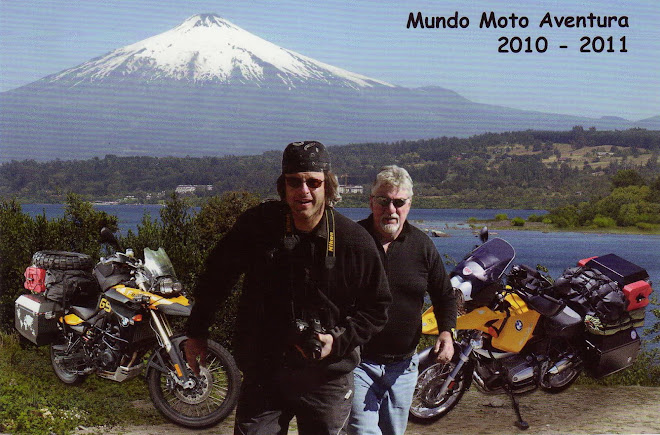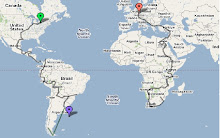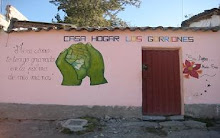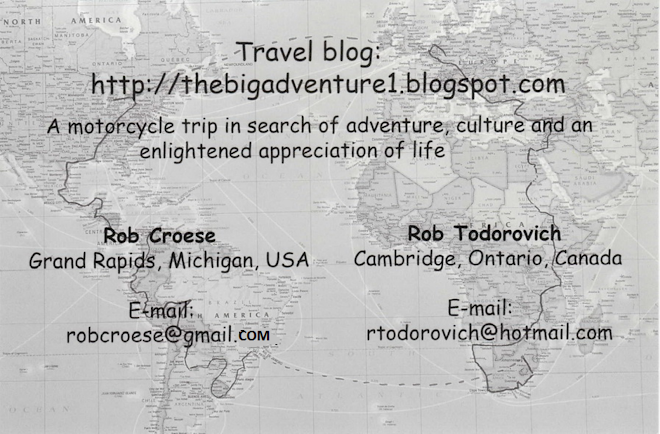RobT: Day 74: We decided to take a rest day in beautiful Salta, Argentina, to wash the bikes, do laundry and get my riding pants repaired. My "excellent" riding pants let go at the seams ( I guess letting in so much water compromises the seams). RobC complained about how they were an eye sore, buffeting in the wind as he followed behind. My steed and I have become quite the "gypsy" wagon with all sorts of items in need of repair and attention.
In the evening we strolled down an interesting area known in Salta as La Estación, (the old train station district), a street lined with restaurants and show houses set in the old buildings. The old train station was at the end of the street. (RobC said the place reminded him of Church Street Station in Orlando.) The place we ended up at was called La Vieja Estación. The show, called a Peña Folklórica, traditional Argentine dance and music. At one point, the professional dancers (2 couples), picked members from the audience to go up and join them in the Samba, the Argentine version of the Marinera in Peru and the Cueca in Chile (which according to RobC are traditional "courting and male/female conquest" dances). Guess who was chosen to dance with one of the professionals? The same happened to me 4 years ago at a Peruvian Peña in Lima, where I had summarily embarassed myself and my country with some moves on stage that can only be described as sporadic convulsions. True to form, I did it once again, much to RobC's amusement and no doubt all others present in the establishment (RobC edit: Robbie did just fine and was really delighted by the kiss on the cheek from his pretty partner). Anyway, aside from that, the show was very enjoyable, the wine was great and the food was....well, peña food!
RobC: Salta, in the northern Andes of Argentina, is a delightful place. The weather is superb, with bright mountain sun during the day and crisp, cool nights. The city itself has some beautiful architecture, large plazas with many sprawling outdoor terraces, beautiful jacaranda trees, sharply dressed women and smiling children. In short, the kind of place one could easily live for a few years.
We had our laundry done, including our muddy/dusty riding gear, and Rob's pants were sewn to perfection. Everything was ready at 6 pm, as promised, and the cost was something like USD 10/each. The bikes looked brand-new again and we were ready to head East, across the hot, flat Chaco toward Resistencia/Corrientes tomorrow.
RobT: Day 75: We had a long, hot day ahead of us, some 800 km (500+ miles) through the Chaco, a Northern Argentine flat land. The only curve on the road was a U-turn we had to do after we found out we had been heading in the wrong direction for some 40 km (25 miles). The rest was straight as an arrow, flat and blazing hot. The temperature reached 40 Celcius (110 F) and with all the gear on it felt like 140 F!! This was the Chaco.
We had trouble finding a gas station that had fuel and when we finally did there were long line ups.This remote northern part of Argentina has trouble getting a steady supply of fuel.
Our adventure sticker made it onto yet another door in a foreign country (bottom middle), along with all the stickers of Brazilian long-distance bikers.
Ruta 16 in the Chaco
The name of the town summarizes this area. Pampa del Infierno (The Pampa from Hell)
Other than the hot road - not much there!
At about 160 km (100miles) from our destination (700 km (450 miles) into the ride that day), things took a turn for the worse. Everyone has a limit as to the amount of adventure they can handle or are willing to endure. We are no different and today we found our limit.
RobC was in the lead, traveling at about 100 kph (65 mph), I was about 50 ft behind and to the right when I heard him emit a panic sound over the intercom. I looked to the left and noticed he was on the center line, dust was being kicked up as if he was on gravel. Weird. It all happened so fast, yet in slow motion ... if that makes any sense. I wasn't sure what was going on until his bike fell over to the left at highway speed. I saw Rob sliding away from the bike across the opposite lane toward the wide gravel shoulder. Luckily there was no oncoming traffic, which was odd as the highway had become quite busy during that last hour of riding. This could have been much worse if he had slid into a truck or a car. Rob disappeared from my peripheral vision as I braked and headed for the right shoulder as I saw his bike slide across the road in front and to the left of me. After a long slide the bike hit the shoulder and then disappeared in a huge cloud of dust and flying debris. I had visions of the motorcycle being totaled. By the time I parked my bike and ran across the road toward Rob (I could still hear him over the intercom), he was asking me to turn his bike off, as the motor was roaring. There were already 3 or 4 people around him offering any help they could. Rob was standing, looked okay and sounded normal, so I turned around to go back down the road and turn the bike off. It had come to rest just just short of a guard rail, facing the opposite direction. I couldn't believe what just happened!! I picked up the bike and started inspecting the damage, while Rob made his way over to have a look as well. There was a lot of damage, headlight lens broken, faring bent, handle bars bent, crash bar pushed back, puncturing the hydraulic clutch cable, top box and right side pannier ripped right off the bike, passenger peg bent 90 degrees, gas tank scratched and dented, the auxiliary gas container gouged (no fuel leak though), GPS mount damaged, etc, etc. Wasn't sure if the bike was rideable, but we needed to get Rob some medical help, as his back was starting to spasm and he had some road rash on his arms. The gear did its job. His pants showed a lot of damage, his mesh jacket had some holes in the sleeves, but the gloves and helmet received minor damage, although you never know about a helmet once its hits the ground.
Right beside the crash site was a hotel (Hotel Refugio) and a Shell gas station .... it was an unassuming, but very functional hotel. The next few hours were spent trying to get the bikes and related parts over to the hotel, some medical attention for Rob and some food and drink. As it turns out, that evening the hotel owner was having a staff party in the traditional Argentine holiday spirit (this was December 23), an Asado (barbeque). We were invited to join and were treated like long lost family members. It was incredible!!!!! Anything we needed they provided, with enthusiasm!! Everyone, from Marcelo, (the hotel owner and his lovely wife), Marcelo's mother and step-father, Francisco, Pedro, Susana
and others told RobC that if he had to crash, he could not have picked a better spot. We were in great hands here!
RobC: Let me a add a little bit to Rob's excellent accounting of my mishap. I don't know exactly why or how, but I suddenly felt the wheels of the bike stuck to a center ridge in the road and as the bike had a left-leaning bias, I could not get loose from the ridge and the bike just tipped over to the left and unloaded me, sliding in an angle across the oncoming lane. The bike took on a different, more angular path across the same oncoming lane. I remember thinking that this could be serious, but the slide itself was quite smooth until I got to the gravel, at which time the slide turned into a flipping and rolling event. When I finally came to a stop (after some 50 meters (150 feet)) I gather my wits together and got up to assess the damage. No serious structural problems, so I got up to have a look at the bike, which had slid quite a bit further than I did, presumably because it is heavier.
Things did not look very good. My pretty yellow (mandarin) GS was severely scraped, bent and busted on its left side. I had visions of throwing the business into a crate and heading home.
About that time a pick-up truck showed up with three policemen, who were intent on knowing what happened and write a short handwritten report. They were not too concerned about my physical condition, but when hen they saw my scraped elbows they insisted on taking me to the local "hospital" to get checked out. My back had started to spasm and I had a hard time getting into the pick-up truck.
At the hospital emergency room (which had a lot of ominously-looking mechanical and medical tools lying around) there was a crying, beat-up woman and I wondered what in the world I was doing there. After a short wait, a couple of large matronly nurses proceeded to douse me with hydrogen peroxide and iodine, making me wince in pain, while I was looking for a way to escape this unpleasant place. Shortly thereafter a kind, handsome doctor came to inquire about my condition, but he was obviously distracted by more serious issues (and my mentioning the back spasms were ignored by "Sorry, we do not have an X-ray machine" ). So, I guessed I was free to go, and I walked back to the scene of the accident (with lots of back pain at that point), where I noticed that everything had been nicely and neatly removed to the roadside hotel. RobT had everything in well in hand and all I had to do was try to lie down and get some liquids into me and try to get some rest. The problem was that I could not lie down or sit from the pain, about all I could do was stand and walk around a bit.
I asked Rob to see whether he might find some sort of a local "bone cruncher or manipulator" to work on my back. After an hour he came back, saying that there was a kinesiologist (physical therapist) willing to see me at this late hour (about 8 pm). So, our friend Victor, a lumber trucker, who had helped us throughout the ordeal, took me to the kineseologist and waited for an hour while I received some sort of magnetic treatment to the left sacroiliac joint where I had the worst pain, as well as some manual stretching. She also made arrangements at a local clinic to have an X-ray taken and for a doctor to see me. So, after lowering my aching body once more into Victor's little car, we headed for the clinic.
The X-ray showed no structural damage according to the radiologist - his fee: 40 pesos (10 USD). The doctor gave me a prescription for injectable Diclofenac - his fee: 50 pesos (12.50 USD). Victor took me a pharmacy, we got the injectables and syringes (fee: 29 pesos (7.40 USD). Back to the clinic to have a nurse apply the first of 3 injections - injection fee: 6 pesos (1.50 USD). Somewhere along the line, Vicor had picked up his wife and little daughter, Jaqueline, and we headed back to the hotel, where RobT was fully engaged in the hotel staff's end-of-year party (asado). They immediately invited me to join and showered me with food, barbequed meat and beer. By about 3 am the party dwindled down and my back had started to feel quite good, but I wondered if that was due to the medication, the beer or both. :-)
Here are some pictures of the scene by RobT, who, by the way, acted like a real trooper throughout the whole ordeal!! I also think we learned some valuable lessons: i.e. always be vigilant and ready for the unexpected (this was the first time in 20,00 km that we found an obstacle of this type in the center of the road), rest more frequently on hot days, be careful about bright sunlight at the end of the day, etc.
This is the "center curb" that caused all the problems ... about 2-3" high and 6" wide and chamfered on the sides.
Same color as the asphalt and extremely difficult to see when on the road. Further down the road this curb was even painted yellow to match the double yellow center line. Unbelievable.
Pictures of RobC's damaged bike
Our amazing friends in Quitilipi at the end of the staff party!!


































































